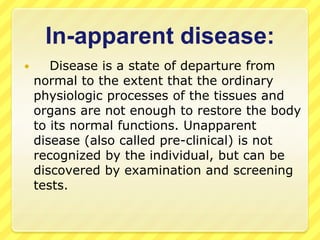1 public health and preventive medicine
- 2. HEALTH Health is a state of complete physical, mental and social well being and not merely the absence of disease or infirmity
- 3. SPECTRUM OF HEALTH Ideal health Positive health Negative or marginal health In apparent disease Apparent disease Death
- 4. Ideal health: This conforms to the WHO definition of health
- 5. Positive health Perfect continuing adjustment between the individual and the environment. This definition indicates that health is a positive dynamic interaction between the individual and his surroundings with proper acclimatization to maintain health.
- 6. Negative or marginal health: If the individual is in a state of equilibrium, he looks healthy, but he has no ability to adjust himself to his surroundings, then he is going to fall ill on the slightest adverse stimulus.
- 7. In-apparent disease: Disease is a state of departure from normal to the extent that the ordinary physiologic processes of the tissues and organs are not enough to restore the body to its normal functions. Unapparent disease (also called pre-clinical) is not recognized by the individual, but can be discovered by examination and screening tests.
- 8. Apparent disease: The individual is aware that s/he is suffering from an illness, whether s/he seeks medical care or not.
- 9. Epidemiology (Epi = on, and demos = people) Epidemiology is the subject concerned with study of what happens to people when involved by disease, whether communicable or non-communicable It is defined as the study of distribution, frequency, determinants, and dynamics of diseases in human populations.
- 10. Factors affecting the occurrence of a disease Human being (host factors) Environment Causative Agent
- 11. Host Factors Heredity and genetic factors Age and sex Health status Previous immunologic experience Physiologic state Life style: e.g. smoking. Socio-economic status
- 12. Environmental Factors The physical environment The Biologic environment The social/cultural environment
- 13. Disease Causation and Epidemiological Triad:
- 14. Risk Factors and Etiological Factors:
- 15. Simple disease caustaion & Multiple risk factors
- 16. Causative Agent: Biologic agents Nutritional agents Chemical agents: Examples are poisons, insecticides, and even some drugs. Physical agents: Excessive heat or cold , electricity, irradiation, .... Mechanical agents: causing injuries or accidents. Metabolic agents: e.g., phenylketonuria, galactosemia,.. Genetic agents: as in Down's syndrome. Functional: Dysfunction of certain organs or gland may produce disease, e.g., Diabetes Mellitus.
- 17. Risk Factors: These are factors that make an individual, a family, a group of individuals, or a community, more prone to a specific disease due to the presence of a certain factor which is not the direct causative agent. The causative agent may be known or unknown. The risk factors are related to the host or his/her self specific environment.
- 18. PUBLIC HEALTH Public health is "the art and science of promoting health, preventing disease and increasing the span of healthy life through organized efforts of the society". Another definition, which has almost the same meaning "public health can be defined as the combination of sciences, skills and beliefs that are directed to the maintenance and improvement of the health of all the people."
- 19. Essential public health functions includes: Protection of the environment Health education Health legislation, and health regulations Prevention and control of communicable diseases Care for special groups as mothers, children, and workers in certain hazardous occupations Assessment of health needs, plans and supports the provision of health care services to the population
- 20. Community Health / Community Medicine: Is the application of the principles of public health to communities. A community is a group of individuals sharing an identity, culture, and operates through common institutions and organizations. A health Center in a rural or an urban area is responsible for the health of the community they serve within their catchment area.
- 21. Preventive Medicine: is the science and art of application of the different levels of prevention at the population, community, and individual levels.
- 22. PATTERNS OF CARE PREVENTIVE CARE CURATIVE CARE
- 23. Levels of Prevention: Primary Health Promotion Specific Prevention Secondary Early detection of diseases Prompt and appropriate treatment Tertiary Rehabilitation
- 24. Patterns of curative care: Emergency care Episodic care Continuous care Terminal care
- 25. Comparison between clinical medicine and community medicine Clinical Medicine Community Medicine _________________________________________________________________ Objective Patient cure Health improvement Information Complaint, history and related factors morbidity, mortality Investigations Laboratory tests, Survey studies Diagnosis X-ray, other tests Differential diagnosis Resources Available therapy Management Treatment Evaluation status Follow-up of patient Community diagnosis & priority setting Health & Health related services Health programs Assessment of health
- 26. THANK YOU

























